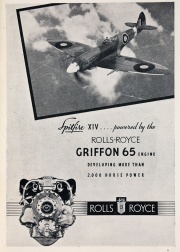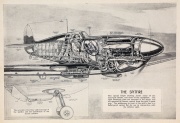Supermarine: Spitfire



Note: This is a sub-section of Supermarine
General
Type
- Fighter
Designers
Manufacturers
Production Dates
- 1938-48
Number produced
- 20,351
Engines
Single seat fighter. Produced by the Supermarine subsidiary of Vickers-Armstrongs, the Spitfire was designed by the company's Chief Designer R. J. Mitchell, who continued to refine the design until his death from cancer in 1937, the position of chief designer then filled by his colleague, Joseph Smith. Its elliptical wing had a thin cross-section, allowing a higher top speed than the Hawker Hurricane and other contemporary designs; it also resulted in a distinctive appearance, enhancing its overall streamlined features. Much loved by its pilots, the Spitfire saw service during the whole of the Second World War and subsequent years, in all theatres of war, and in many different variants. Powered by one 1,030 hp Rolls-Royce Merlin II or III.
20,351 aircraft were built.
The Spitfire by Bert Martin
Read The Spitfire by Bert Martin a personal essay of the memories of Bert Martin, a toolmaker at Follands responsible for the Spitfire tail portion.
Variants
Although R. J. Mitchell is justifiably known as the engineer who designed the Spitfire, his premature death in 1937 meant that all development after that date was undertaken by a team led by his chief draughtsman, Joe Smith, who became Supermarine's chief designer on Mitchell's death.
There were 24 marks of Spitfire and many sub-variants. These covered the Spitfire in development from the Merlin to Griffon engines, the high-speed photo-reconnaissance variants and the different wing configurations. More Spitfire Mk Vs were built than any other type, with 6,487 built, followed by the 5,656 Mk IXs.
The Mk. III Spitfire was designed to accommodate the more powerful Rolls-Royce Merlin XX engine. This had a two-speed supercharger, which increased the length of the engine. Due to the length of time required to get the Mk. III into production, Rolls-Royce produced a variant known as the Merlin 45, intended as a stopgap. This had the XX supercharger, but without the two-speed gearbox. The first Spitfires fitted with this engine were ready in February 1941, and were designated Mk. V (Mk.IV was being developed to accommodate the larger Rolls-Royce Griffon engine).[1]
The first Rolls Royce Griffon-engined Mk XII flew on August 1942, and first flew operationally with 41 Squadron in April 1943. This mark could nudge 400 mph (640 km/h) in level flight and climb to an altitude of 33,000 ft (10,000 m) in under nine minutes.
- See also Seafire.
See Also
Sources of Information
- ↑ 'The Secret Horsepower Race - Western Front Fighter Engine Development' by Callum E. Douglas, Tempest Books, 2020
- Wikipedia
- some images from Flight Magazines.






















